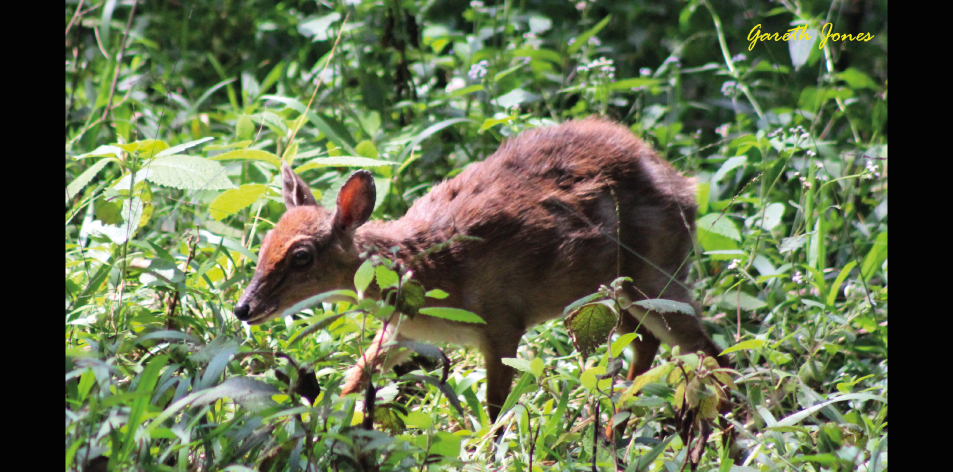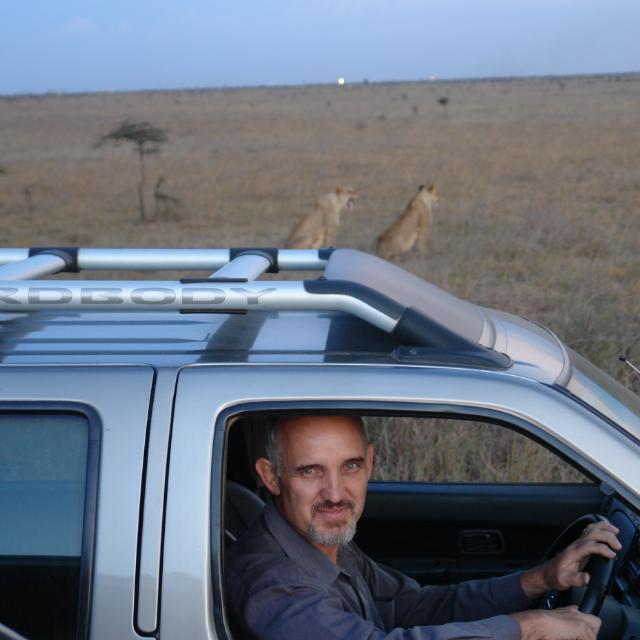
Our Forest Has Secrets! – Article by Gareth Jones
NAIROBI NATIONAL PARK – SECRETS OF THE FOREST!! – BY GARETH JONES
There is something mysterious and wondrous about being in a natural forest, and the Langata forest part of the Nairobi National Park is such a place. The thick bush is a hiding place for many species, including some rarely seen species. Driving slowly along some of the many narrow roads through the forest, often causes me to have a feeling that there could be a special sighting at any moment.
A while ago, it was a beautiful sunny afternoon as we drove through the forested area of the park, suddenly we saw the carcass of a large buffalo near the road. Naturally we suspected that this was a lion kill, as the carcass was partly eaten. I decided to drive forward a short distance to reposition our vehicle, and wait to see if there were perhaps lions nearby.
As we approached the carcass again a lioness appeared and spent a few minutes feeding, however judging by the size of her full belly, she definitely was not starving. Then two fat bellied cubs also came out of the bushes and had their turn at the carcass. The lioness and the cubs then moved away to find suitable shade to rest. We waited for about an hour, until eventually a large male lion appeared and began to feast on the buffalo carcass. We recognized him as Mohawk, one of the dominant males in the park. Mohawk gripped the carcass in his powerful jaws and pulled it for about 10 metres to allow himself to gain access to the meat on the other side.Wow! what a display of raw power, as Mohawk made the task of moving a large buffalo look easy. Mohawk enjoyed his afternoon feast for some time until the cubs reappeared for another snack. After two hours of watching the lions feasting, we noted that this was part of the Kingfisher pride, and that there was still quite a bit of meat remaining on the carcass, leaving no doubt this feast in the forest would continue for at least another day or two. Meat is meat and lions must eat! The lions of the Nairobi National Park live a very challenging life, it is always amazing to consider that somehow year after year the lions continue to survive.
When driving through the Langata forest, sometimes when we least expect to see something special, it is when we are not completely ready. I had just driven from the Langata gate very early one morning a few years ago, when as I rounded a corner, three tiny little striped furry creatures ran across the road in front of me. Just as I was trying to register, a large bushpig crashed through the bushes, crossing the road in front of me, and running after its new born babies, no doubt to try and protect them from the unexpected visitor in the noisy fuel smelling metal machine. The adults can be very aggressive, especially when they have young. I watched as the bushpig quickly herded the piglets to the safety of thick forest bush. WOW! What a rare and awesome sighting, just as I was about to drive away another bushpig (possibly the boar) charged across the road to join the rest of the family. Then I scolded myself for not having my camera ready to take photos of the piglets, however I did manage to do a quick click of the sow before she disappeared into the thick bushes.
In many years this was only my second sighting, I remember many years ago finding some bushpig feeding on the carcass of a young dead buffalo, as they do also eat meat occasionally. Bushpigs are seldom seen because of their predominantly nocturnal secretive habits and because they normally frequent thick bush. The sub-species of bushpig found in the Nairobi area is Potamochoerus larvatus hassama. Bushpig although rarely seen can be found in the forested and riverine areas of the Nairobi National Park. So just remember to always be ready! Sometimes action happens very near to the main gate, drive in the early morning or late afternoon slowly through the trees, it will always be rewarding.
The park has been very wet due to heavy rains this year, with areas like the Langata forest being particularly swamped and the roads being virtually impassable. However last week we decided that the forest might be dry enough in places. We drove slowly as the roads were seriously eroded in many parts. Soon we approached one of my favourite lush shady forest meadows. Suddenly I saw a movement, and observed that it was a small reddish coloured antelope. “WOW!” It was the rarely seen secretive Harvey’s Red Duiker. Amazingly the duiker did not seem particularly concerned with our presence and continued feeding long enough for us to observe its feeding behavior for at least five minutes and take a few decent photos. All to soon, another vehicle approached from the opposite direction and the red duiker bounded away with a distinctive diving, zigzag motion (from which comes the name duiker, meaning diver in Afrikaans) and disappeared into the thick shrubs.
There are two duiker species found in the Nairobi National Park, the common duiker and the smaller Harvey’s red duiker. Both species are uncommon and not often seen, however the Harvey’s red duiker is very rarely seen due to their secretive nature and low scarce population.
In Africa, there are 22 subspecies of the duiker subfamily Cephalophinae, found in two main geographical areas, and are either known as bush duikers or forest duikers. Both males and larger females may have horns. Duikers are found in dense scrub, bush and woodland, and are independent of water when green food is available. They mostly eat wide range of trees and bushes, fruits, pods and seeds, roots, caterpillars, bark, flowers and even nestling birds. Expected lifespan is 8 to 11 years, and single lambs are born.
Next time you drive through the forest be on the lookout for the secretive Harvey’s red Duiker, or maybe another secretive creature might reveal itself . God has created many wonders for us humans to enjoy and appreciate!
The park is open daily from 06h00 to 19h00.
Gallery


